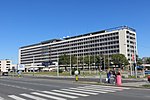Mercator Center Belgrade
Buildings and structures in Belgrade

Mercator Center Belgrade (Serbian: Меркатор Центар Београд), located in Belgrade's municipality of New Belgrade, is the biggest Mercator Serbia Center in the retail chain.
Excerpt from the Wikipedia article Mercator Center Belgrade (License: CC BY-SA 3.0, Authors, Images).Mercator Center Belgrade
Boulevard of Art, Belgrade New Belgrade (New Belgrade Urban Municipality)
Geographical coordinates (GPS) Address Phone number Website Nearby Places Show on map
Geographical coordinates (GPS)
| Latitude | Longitude |
|---|---|
| N 44.82052 ° | E 20.41411 ° |
Address
Меркатор центар
Boulevard of Art 4
11000 Belgrade, New Belgrade (New Belgrade Urban Municipality)
Central Serbia, Serbia
Open on Google Maps









